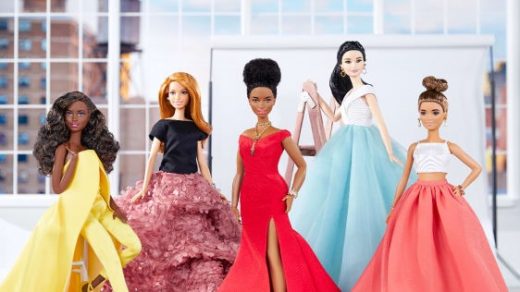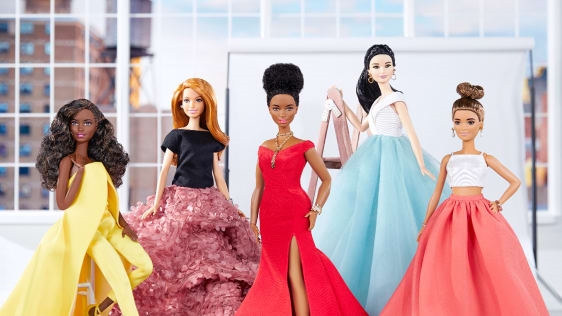Barbie’s 17 New Skinny Dolls Are Not The “Role Models” Girls Need
To celebrate International Women’s Day, Mattel has released 17 new Barbie dolls based on real women.
In a study that Barbie conducted, 81% of 8,000 moms who had daughters under the age of 10 said they were worried about the types of role models their little girls were exposed to. These new dolls are a direct response to this anxiety. “We are thrilled to shine a light on real life role models to remind them that they can be anything,” Lisa McKnight, SVP and GM of Barbie, said in a statement announcing the collection.
At first blush, the toy brand has done an admirable job of highlighting inspirational women of many different ethnicities from around the world who have an impressive array of achievements. There’s Wonder Woman director Patty Jenkins from the United States, two Michelin-star French chef Hélène Darroze, and Chinese ballerina Yuan Tan. There are even historical icons like artist Frida Kahlo, NASA mathematician Katherine Jenkins, and pilot Amelia Earhart.
And some even come with props! Olympic gold medalist Chloe Kim has her own snowboard, Australian conservationist (and Steve Irwin’s daughter) Bindi Irwin comes with a koala bear, and Chinese volleyball champion Hui Ruoqi has a ball in tow.
The dolls’ faces, eye colors, and hairstyles appear carefully designed to capture the likenesses of the real woman each is meant to represent. But for all this attention to detail, it seems strange that Mattel made all the dolls rail thin. In fact, the dolls’ bodies are almost identical each another–which is the first tip-off that something is amiss. Irwin’s doll is a little shorter than her counterparts, while Ruoqi’s is slightly taller, and Spanish entrepreneur Vicky Martin Berrocal’s is a smidge curvier, but there is nothing realistic about these dolls at all.
It’s an odd move for Mattel. Since 2009, Barbie sales have spiraled downward. Between 2012 and 2014 alone, the brand’s sales plummeted by 20%. While part of this shift has to do with kids preferring electronic toys over analog ones, analysts say that part of the decline is due to parents who believe Barbie is a bad influence on girls. A slew of research has found that playing with Barbie makes girls feel lower self-esteem about their bodies.
In response, Barbie made a big push towards body inclusivity at the start of 2016 by releasing Barbies in three new body types: curvy, petite, and tall. These dolls came in seven skin tones, 22 eye colors, and 24 hairstyles. But when I was reporting a story about Barbie last December, I couldn’t find many of these curvy dolls in stores. The vast majority tended to come in the original body shape, which consists of enormous breasts, a minuscule waist, and very thin legs. If a real woman had Barbie’s proportions, she would have half a liver, a tiny intestine, and would tip over since her legs would not be able to support her weight.
It is this body type that Mattel appears to have gone with for its International Women’s Day collection. And it doesn’t reflect the reality of the women they are modeled on. It’s true that there are athletes within the group, but they look healthy and fit, not Barbie-like. British boxer Nicola Adams and Gama, the soccer player, are strong and muscular. They don’t look like they’re about to topple over because of their outrageous cup size.
Chef Darroze, meanwhile, is full-figured and bears no resemblance to her doll, which Twitter users immediately noted. “Barbie, it’s great that you wanted to honor Hélène Darroze but do you really think that the doll accurately represents her?” one asked. “Not every woman has the same body shape @Barbie. Should our little girls think they need to be skinny to be pretty?” another chimed in.
@Barbie c’est merveilleux d’avoir voulu honorer @HeleneDarroze mais vous pensez vraiment que la poupée la représente fidèlement ????? #PeutMieuxFaire #BarbieStyle #Barbie pic.twitter.com/1NFc8II56M
— Guillaume Eyango (@Eyango) March 7, 2018
It’s unfortunate because the goal of this International Women’s Day collection was to encourage girls to follow in the footsteps of these accomplished women at the top of their fields. “We know that you can’t be what you can’t see,” McKnight said. (We reached out to Mattel for a comment, but could not connect by press time.)
But when a girl sees these dolls, she sees an unrealistically skinny figure. What kind of message is it sending to young girls that Mattel felt the need to remake these women’s bodies so that they would be conventionally attractive enough to fit into the Barbie brand? It doesn’t even make much business sense, since millennial parents–who are the ones buying the dolls–have been calling for the brand to create dolls with more realistic body types.
If Barbie wants to make a comeback, the brand needs to do more than represent women of different ethnicities and walks of life. Mattel needs to create dolls that look like real women. More crucially, it needs to believe that bodies of all shapes and sizes are beautiful enough to be turned into dolls.
(68)



